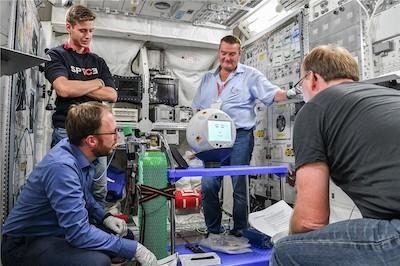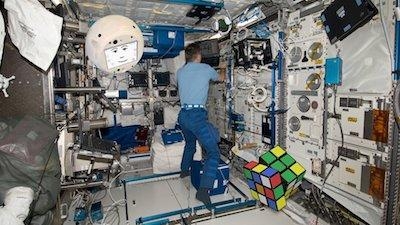A Successor To The Technology Experiment Will Have Additional Functionality, And Is Currently Being Built And Tested By Airbus
CIMON has returned to Earth: the Crew Interactive Mobile CompanioN (CIMON), the astronaut assistant featuring artificial intelligence, arrived back on its home planet on board a Dragon spacecraft from US company SpaceX. The SpaceX-18 undocked from the International Space Station (ISS) on August 27, 2019 at 16:59 Central European Summer Time (CEST). The capsule then touched down in the Pacific Ocean around 260 nautical miles southwest of Los Angeles and was recovered at 22:21h CEST.

“We expect to have the first CIMON back in Germany by the end of October,” says Dr Christian Karrasch, CIMON Project Manager at the DLR Space Administration. “The CIMON technology experiment has lived up to all our expectations,” Karrasch continues, summarising the past few months. “During its first mission in space – a 90-minute session with German ESA astronaut Alexander Gerst on the ISS in November 2018 – CIMON demonstrated its ability to work well in microgravity conditions and to successfully interact with astronauts. We are still incredibly happy with the only artificial intelligence mission to take place on the space station to date, and have been working on a new, enhanced model for several months. The first CIMON has allowed us to lay the foundations for using social assistance systems in space – systems that support astronauts with their tasks and that at some point may even take some work off their hands.”
Just like its predecessor, the second CIMON is being built by Airbus in Friedrichshafen and Bremen on behalf of the DLR Space Administration and is being funded by the German Federal Ministry for Economic Affairs and Energy (Bundesministerium für Wirtschaft und Energie; BMWi). Airbus in Friedrichshafen has assembled and tested the hardware for the new CIMON, while Airbus in Bremen is working to improve the software for flight and attitude control. IBM is implementing new AI features. “All in all there are several upgrades, including better microphones, a more robust computer, improved flight and attitude control, and new software features for conversation – for example in the areas of voice recognition, conversational skills and understanding intentions,” explains Till Eisenberg, CIMON Project Manager at Airbus.

"CIMON represents a unique application scenario in an extreme working environment. And we’ve seen that by using AI technology – in our case IBM Watson – we can support astronauts in their work," said Matthias Biniok, Project Manager at IBM. "Our primary objective for CIMON’s next stage of development is to improve the comprehension of speech in specific contexts and the analysis of emotion in language.”
Ethical questions around the future use of CIMON are being examined and evaluated by medical experts at Ludwig-Maximilian University (LMU) in Munich. Privacy rights are affected by the interaction between humans and machines, as CIMON records, processes and interprets images and audio of astronauts. There needs to be high technical standards in data security while recognising that trust in such systems is an important factor for teamwork between humans and machines. Basically, this means deciding what CIMON is permitted to do, know and say. “The new CIMON has an in-built switch that allows the flow of data from all cameras and microphones to be interrupted from the ISS. This means that the astronaut is in control of CIMON at all times, which we thought was particularly important,” says LMU scientist Dr Judith Buchheim.
DLR Space Administration, which is responsible for German contributions to the European Space Agency (ESA), is working with ESA to send the new version of CIMON to the ISS in December 2019 so that it can benefit from crew time with astronauts.
The first CIMON arrived on the ISS as a technology experiment on July 2, 2018. On November 15, 2018, the robotic assistant with a smart ‘face’ received global attention when it was deployed for the first time: it successfully ‘worked’ together with German ESA astronaut Alexander Gerst for 90 minutes. CIMON demonstrated its basic functions, such as its ability to fly in microgravity conditions using autonomous navigation, performing several turns and movements in every direction, and was able to search for Gerst’s face, recognise it, make eye contact and speak to him. It then showed the instructions for an experiment on its ‘face’ – a display in the centre of the sphere – and played music. It also used its cameras to record a video and take a photo of Gerst.
In 2018, the CIMON project won the US ‘Popular Science Award’ in the category ‘Best of What’s New in 2018’ in aerospace. Airbus was also awarded the ‘2019 German Innovation Prize’ (Deutsche Innovationspreis) in the large companies category.
(Images provided with Airbus news release and from file)
 A Crazy Tesla Flying Car is Coming
A Crazy Tesla Flying Car is Coming ANN's Daily Aero-Term (11.xx.25): NonApproach Control Tower
ANN's Daily Aero-Term (11.xx.25): NonApproach Control Tower Aero-News: Quote of the Day (11.01.25)
Aero-News: Quote of the Day (11.01.25) ANN's Daily Aero-Linx (11.01.25)
ANN's Daily Aero-Linx (11.01.25) Classic Aero-TV: EAA Introduces Angle of Attack Training
Classic Aero-TV: EAA Introduces Angle of Attack Training




